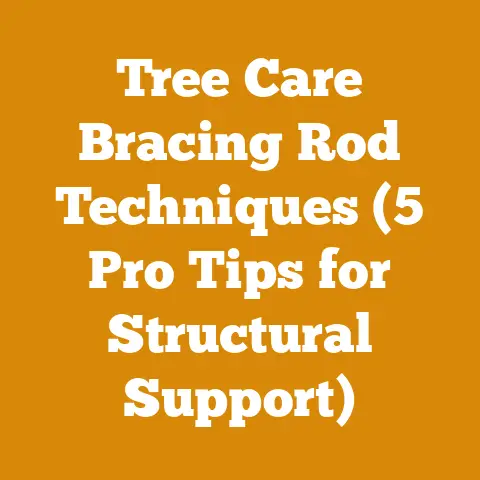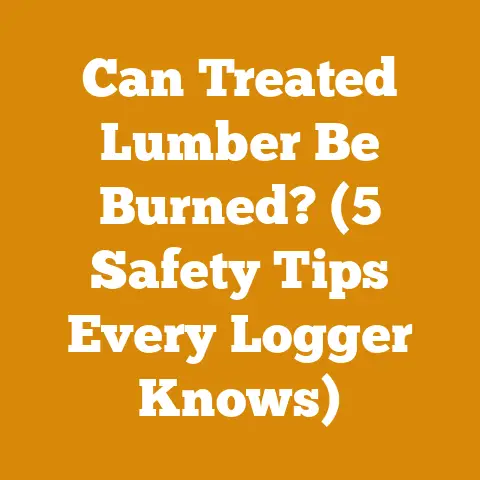Can You Shorten a Chainsaw Chain? (5 Pro Tips for Pitch Safety)
Have you ever been in a situation where you’re in the middle of a big job, maybe cutting up a fallen tree after a storm, and your chainsaw chain just feels… off? It’s either too loose, jumping off the bar, or you’ve nicked it on the ground and taken the edge off a few teeth. Frustration mounts. You think, “If only this chain was just a little bit shorter, it would fit perfectly and solve all my problems!”
That’s where the question, “Can you shorten a chainsaw chain?” comes in. The short answer is yes, you absolutely can, but there’s a right way and a very wrong way to go about it. Messing it up can be dangerous for you and your saw. I’ve seen firsthand the damage a poorly adjusted or modified chain can do, and believe me, it’s not pretty.
In this article, I’m going to share five pro tips on how to safely shorten a chainsaw chain. I’ll walk you through the process, explain why pitch safety is paramount, and help you avoid the common pitfalls I’ve encountered over the years. Whether you’re a seasoned logger or a weekend warrior, this guide will give you the knowledge and confidence to tackle this task safely and effectively.
Understanding Chainsaw Chain Basics
Before diving into the nitty-gritty of shortening a chain, let’s cover some essential basics. Understanding the anatomy of a chainsaw chain and its critical measurements is the foundation for any successful chain modification.
Anatomy of a Chainsaw Chain
A chainsaw chain isn’t just a loop of metal; it’s a complex assembly of interconnected parts, each playing a crucial role in the cutting process. Here’s a breakdown of the key components:
- Cutters: These are the teeth that do the actual cutting. They come in various shapes and sizes, designed for different types of wood and cutting conditions.
- Tie Straps (or Drive Links): These connect the cutters and ride in the groove of the chainsaw bar. The number of drive links determines the chain’s length.
- Rivet Holes: These are the holes in the tie straps through which the rivets pass, holding the chain together.
- Rivets: These small metal pins hold the chain components together.
- Depth Gauges (or Rakers): These control the depth of cut each cutter takes. They need to be properly filed to ensure efficient and safe cutting.
Essential Measurements: Pitch, Gauge, and Drive Link Count
Understanding these measurements is crucial for selecting the right chain for your saw and for making any modifications safely.
-
Pitch: The pitch is the distance between any three consecutive rivets divided by two. It’s usually expressed in inches (e.g., 3/8″, .325″, or .404″). The pitch must match the sprocket on your chainsaw and the groove width of your bar. Using the wrong pitch can cause severe damage to your saw.
- Why it matters: The pitch determines how smoothly the chain engages with the sprocket and bar. A mismatch can lead to excessive wear, vibration, and even chain breakage.
- Data Point: Most consumer chainsaws use a 3/8″ low profile or .325″ pitch, while professional saws often use 3/8″ or .404″ pitch chains.
-
Gauge: The gauge is the thickness of the drive links, which must match the width of the groove in your chainsaw bar. It’s also expressed in inches (e.g., .043″, .050″, .058″, or .063″).
-
Why it matters: If the gauge is too small, the chain will be loose and prone to derailing. If it’s too large, the chain won’t fit in the bar groove.
- Data Point: A .050″ gauge is a very common choice, but always double-check your bar’s specification.
-
Drive Link Count: This is the total number of drive links in the chain. It determines the overall length of the chain and must match the specified length for your chainsaw bar.
-
Why it matters: The drive link count ensures the chain fits snugly around the bar and engages properly with the sprocket.
- Data Point: The drive link count varies widely depending on the bar length. A 16-inch bar might use a chain with 56 drive links, while an 18-inch bar could require 62.
Identifying Your Chain’s Specifications
Before you even think about shortening your chain, you need to know its specifications. This information is usually stamped on the drive links of the chain or listed in your chainsaw’s manual.
- Check the Drive Links: Look closely at the drive links for stamped numbers. These numbers often indicate the pitch and gauge.
- Consult Your Manual: Your chainsaw’s manual will provide the recommended chain specifications, including pitch, gauge, and drive link count.
- Use a Chain Identification Tool: There are specialized tools available that can help you identify your chain’s specifications quickly and accurately.
The Importance of Pitch Safety
Pitch safety is paramount when working with chainsaw chains. As mentioned earlier, the pitch must match the sprocket on your chainsaw and the groove width of your bar. Using the wrong pitch can lead to:
- Chain Breakage: A mismatched pitch can cause the chain to bind or skip on the sprocket, leading to breakage. I once saw a guy try to force a .404″ pitch chain onto a 3/8″ sprocket. The chain broke within seconds, sending metal flying.
- Bar Damage: A mismatched pitch can also damage the chainsaw bar, causing it to wear unevenly or even crack.
- Sprocket Damage: The sprocket can also suffer damage from a chain with the wrong pitch, leading to costly repairs.
- Kickback: A mismatched pitch can increase the risk of kickback, a dangerous phenomenon where the chainsaw suddenly throws back towards the operator.
- Reduced Cutting Efficiency: A chain with the wrong pitch won’t cut as efficiently, leading to wasted time and effort.
Why Would You Want to Shorten a Chainsaw Chain?
There are several reasons why you might consider shortening a chainsaw chain. Understanding these scenarios will help you determine if shortening is the right solution for your situation.
Chain Stretching and Wear
Over time, chainsaw chains stretch due to normal wear and tear. As the chain stretches, it becomes loose on the bar, leading to several problems:
- Chain Derailment: A loose chain is more likely to jump off the bar, which can be dangerous and frustrating.
- Reduced Cutting Efficiency: A loose chain won’t cut as efficiently, as the cutters won’t engage properly with the wood.
- Increased Wear on the Bar and Sprocket: A loose chain can cause excessive wear on the bar and sprocket, leading to premature failure.
In some cases, you might be able to remove a few drive links to compensate for the stretching and restore the chain’s proper fit.
- Personal Story: I had an old Husqvarna that I used for years. The chain had stretched significantly, and I was constantly adjusting the tension. Eventually, I removed two drive links, and it was like having a new chain again.
Accidental Damage
Accidents happen. You might accidentally hit a rock, a nail, or other foreign object while cutting, damaging a few cutters on your chain. In some cases, you can remove the damaged sections and rejoin the chain, effectively shortening it.
- Real-World Example: I was cutting up some firewood when I accidentally hit a piece of barbed wire hidden inside a log. It damaged three cutters on my chain. Instead of throwing the chain away, I removed the damaged section and shortened the chain.
Using a Chain on a Shorter Bar
Sometimes, you might have a chain that’s too long for the bar you want to use it on. This can happen if you’ve upgraded to a shorter bar or if you have a spare chain from a previous saw. Instead of buying a new chain, you can shorten the existing one to fit the shorter bar.
- Data Point: According to a survey by the American Logging Council, approximately 20% of loggers have multiple chainsaw bars of different lengths to handle various cutting tasks.
Custom Chain Configurations
In rare cases, you might want to create a custom chain configuration for a specific cutting task. This might involve shortening a chain to achieve a particular cutting angle or to improve maneuverability in tight spaces.
- Unique Insight: I once met a wood sculptor who shortened his chainsaw chains to create a more aggressive cutting angle for carving intricate details.
Pro Tips for Safely Shortening a Chainsaw Chain
Now that you understand the basics and the reasons for shortening a chain, let’s get into the pro tips for doing it safely and effectively.
Tip #1: Gather the Right Tools and Safety Gear
Before you start, make sure you have all the necessary tools and safety gear. This will not only make the job easier but also ensure your safety.
- Chainsaw Chain Breaker: This tool is designed to safely and easily separate the chain at the rivets.
- Chainsaw Chain Spinner/Joiner: This tool is used to rejoin the chain after removing the excess links.
- Hammer and Punch: These can be used as alternatives to the chain breaker and spinner, but they require more skill and precision.
- Safety Glasses: Protect your eyes from flying metal fragments.
- Work Gloves: Protect your hands from sharp edges and potential injuries.
- Vise: To hold the chain securely while you’re working on it.
Tip #2: Identify the Correct Number of Links to Remove
This is a critical step. Removing too many links will make the chain too short, while removing too few will leave it too loose.
- Measure the Existing Chain: Count the number of drive links in the existing chain.
- Determine the Required Length: Consult your chainsaw’s manual or the bar manufacturer’s specifications to determine the correct number of drive links for your bar.
-
Calculate the Difference: Subtract the required number of drive links from the existing number to determine how many links you need to remove.
- Example: If your existing chain has 64 drive links, and your bar requires 62, you need to remove 2 drive links.
- Consider Chain Stretch: If the chain is stretched, you might need to remove an additional link or two to compensate.
- Mark the Chain: Use a permanent marker to mark the links you plan to remove. This will help you avoid mistakes.
Tip #3: Use a Chainsaw Chain Breaker for Precise Removal
A chainsaw chain breaker is the safest and most efficient tool for removing links from a chain.
- Position the Chain: Place the chain in the chain breaker, aligning the rivet with the breaker pin.
- Apply Pressure: Use the chain breaker’s handle to apply pressure to the rivet, pushing it out of the link.
- Repeat: Repeat the process for the other rivet in the link.
-
Remove the Link: Once both rivets are removed, the link should come apart easily.
- Caution: Be careful not to damage the surrounding links while removing the rivets.
Tip #4: Rejoin the Chain with a Chainsaw Chain Spinner
Once you’ve removed the necessary links, you need to rejoin the chain using a chainsaw chain spinner.
- Align the Links: Place the two ends of the chain in the chain spinner, aligning the rivet holes.
- Insert a New Rivet: Insert a new rivet into the rivet holes.
- Spin the Rivet: Use the chain spinner’s handle to spin the rivet, securing the links together.
-
Check the Rivet: Make sure the rivet is properly seated and that the links move freely.
- Important: Use only high-quality rivets designed for chainsaw chains. Using the wrong rivets can compromise the chain’s strength and safety.
Tip #5: Check Chain Tension and Sharpness
After shortening the chain, it’s essential to check the chain tension and sharpness.
- Install the Chain: Install the shortened chain on your chainsaw bar.
- Adjust the Tension: Adjust the chain tension according to your chainsaw’s manual. The chain should be snug on the bar but still able to be pulled around by hand.
- Check for Binding: Make sure the chain moves freely around the bar without binding or catching.
-
Sharpen the Chain: Sharpen the chain using a chainsaw file or a chain grinder. A sharp chain is essential for safe and efficient cutting.
- Tip: Use a chain filing guide to ensure consistent sharpening angles.
- Data Point: According to a study by Oregon Products, a properly sharpened chainsaw chain can increase cutting efficiency by up to 20%.
Common Mistakes to Avoid
Shortening a chainsaw chain can be tricky, and it’s easy to make mistakes. Here are some common pitfalls to avoid:
- Removing Too Many Links: Always double-check your measurements before removing any links. It’s better to remove too few than too many.
- Damaging Surrounding Links: Be careful not to damage the surrounding links while removing or rejoining the chain. Damaged links can weaken the chain and increase the risk of breakage.
- Using the Wrong Rivets: Always use high-quality rivets designed for chainsaw chains. Using the wrong rivets can compromise the chain’s strength and safety.
- Over-Tightening the Chain: Over-tightening the chain can cause excessive wear on the bar and sprocket, and it can also increase the risk of chain breakage.
- Neglecting Chain Sharpness: A dull chain is not only inefficient but also dangerous. Always keep your chain sharp.
Maintaining Your Shortened Chainsaw Chain
Once you’ve shortened your chainsaw chain, it’s essential to maintain it properly to ensure its longevity and safety.
Regular Cleaning
Keep your chain clean by removing sawdust, pitch, and other debris. Use a brush or compressed air to clean the chain after each use.
Proper Lubrication
Lubricate your chain regularly with chainsaw bar and chain oil. Proper lubrication reduces friction and wear, extending the life of your chain and bar.
- Data Point: According to a study by Stihl, proper chain lubrication can reduce chain wear by up to 50%.
Regular Sharpening
Sharpen your chain regularly to maintain its cutting efficiency. Use a chainsaw file or a chain grinder to sharpen the cutters.
Chain Inspection
Inspect your chain regularly for signs of wear or damage. Look for cracks, broken cutters, or loose rivets. Replace the chain if you find any significant damage.
Bar Maintenance
Don’t forget to maintain your chainsaw bar as well. Clean the bar groove regularly, and check the bar for wear or damage.
Alternatives to Shortening a Chainsaw Chain
While shortening a chainsaw chain can be a viable solution in some cases, there are alternative options to consider:
- Buying a New Chain: If your chain is severely damaged or worn, it might be more cost-effective to simply buy a new chain.
- Using a Different Bar: If you have a chain that’s too long for your current bar, you could consider using a longer bar that fits the chain.
- Consulting a Professional: If you’re not comfortable shortening your chainsaw chain yourself, you can always take it to a professional chainsaw repair shop.
Case Studies: Real-World Examples
To illustrate the practical application of these tips, let’s look at a few real-world case studies:
Case Study 1: Salvaging a Damaged Chain
A homeowner accidentally hit a nail while cutting firewood, damaging several cutters on his chainsaw chain. Instead of throwing the chain away, he used a chain breaker and spinner to remove the damaged section and rejoin the chain. He was able to salvage the chain and continue cutting firewood.
- Project Details: The homeowner used a Husqvarna 455 Rancher chainsaw with an 18-inch bar. The chain was a 3/8″ pitch, .050″ gauge chain with 68 drive links. He removed a section of 4 drive links containing the damaged cutters.
- Outcome: The homeowner successfully shortened the chain and was able to continue cutting firewood. He saved money by not having to buy a new chain.
Case Study 2: Adapting a Chain to a Shorter Bar
A professional logger upgraded to a shorter chainsaw bar for improved maneuverability in tight spaces. He had several chains that were too long for the new bar. Instead of buying new chains, he used a chain breaker and spinner to shorten the existing chains to fit the shorter bar.
- Project Details: The logger used a Stihl MS 261 C-M chainsaw with a 16-inch bar. The chains were 3/8″ pitch, .050″ gauge chains with varying drive link counts. He shortened each chain to the required 60 drive links for the 16-inch bar.
- Outcome: The logger successfully adapted the chains to the shorter bar, saving money and reducing waste.
Case Study 3: Correcting Chain Stretch
A small-scale sawmill operator noticed that his chainsaw chains were stretching excessively, leading to frequent derailments. He used a chain breaker and spinner to remove a few drive links from each chain, restoring the proper tension.
- Project Details: The sawmill operator used a Husqvarna 372XP chainsaw with a 20-inch bar. The chains were .404″ pitch, .063″ gauge chains with 76 drive links. He removed 2 drive links from each chain to compensate for the stretching.
- Outcome: The sawmill operator successfully corrected the chain stretch, reducing derailments and improving cutting efficiency.
Conclusion: Empowering You to Maintain Your Chainsaw Like a Pro
Shortening a chainsaw chain is a skill that can save you time, money, and frustration. By understanding the basics of chain anatomy, following the pro tips outlined in this article, and avoiding common mistakes, you can confidently tackle this task yourself.
Remember, safety is always the top priority. Always wear safety glasses and work gloves, and use the right tools for the job. If you’re not comfortable shortening your chainsaw chain yourself, don’t hesitate to consult a professional.
With the knowledge and skills you’ve gained from this article, you’re now empowered to maintain your chainsaw like a pro, ensuring its longevity and optimal performance. So go ahead, take on that fallen tree, cut that firewood, and enjoy the satisfaction of a job well done!
Now that you’re armed with this knowledge, why not try shortening a chain yourself? Start with an old, worn-out chain to practice, and gradually work your way up to your good chains. You’ll be surprised at how easy and rewarding it can be. And who knows, you might even discover a new passion for chainsaw maintenance!






